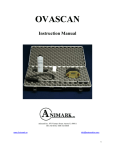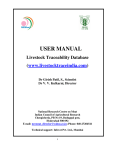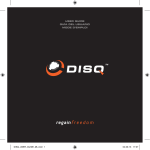Download Pregscan Owner`s Manual
Transcript
PREGSCAN Instruction Manual Animark Inc. 876 Ventura Street Aurora Co 80011 303-343-8342 / 800-532-4048 www.Animark.us [email protected] Table of Contents What is Ultrasound and why does it work for pregnancy detection? ......5 Introduction to the Pregscan......................................................................................5 Pregscan instrument features ....................................................................................7 Sensitivity control ...........................................................................................................7 Reject control ..................................................................................................................7 Sensor................................................................................................................................7 Charge indicator ..............................................................................................................7 Display screen .................................................................................................................8 Range switch ...................................................................................................................8 Pregscan set up................................................................................................................9 Sensor contact .................................................................................................................9 Using the Pregscan with mares ..............................................................................10 Sensor placement on mares.........................................................................................10 Late pregnancy testing .................................................................................................12 Conditions other than pregnancy ...............................................................................16 Record keeping .............................................................................................................17 Using the Pregscan with cows ................................................................................18 Sensor placement on the cow .....................................................................................18 Late pregnancy testing .................................................................................................20 Conditions other than pregnancy ...............................................................................21 Pregscan Trouble Shooting Guide ........................................................................26 Checking your Pregscan ((Tupperware test) optional) ................................24 Care and cleaning.........................................................................................................24 Battery care instructions ...........................................................................................25 Owner responsibility for return shipping...........................................................25 Warranty and service ..................................................................................................27 Warranty validation ....................................................................................................27 Service after warranty period ..................................................................................27 Warranty exclusions ...................................................................................................27 Voided warranty ...........................................................................................................27 Customer service /Assistance .................................................................................28 2 Summary..........................................................................................................................28 Other instruments by Animark ...............................................................................30 Ovascan breeding predictor ........................................................................................30 Pregtest pregnancy detector ........................................................................................30 3 WELCOME Animark is pleased to welcome you to our growing family of satisfied customers. Our company was founded on the principles of quality, integrity and service. As we grow, we continue to practice these principles. Animark pioneered and developed ultrasound pregnancy detection for animals. Among our many other successful instruments are: Boveq Pregnosticator Pregmatic-3 Ovascan Ovatest We have since added several other products to our line, including the new Pregtest and Pregscan. Each type of Animark instrument can do its individual function better than any other product in its class. Better accuracy, better performance, better value. With the purchase of your Pregscan ultrasound pregnancy detector, you have joined a worldwide group of progressive breeders and veterinarians who are realizing the benefits of today's electronic technology applied to animal sciences. Animark's continued research and development has made us the world leader in the field. Our growing list of enthusiastic customers is testimony to Animark's dedication to integrity and service. To obtain the maximum benefits from your Pregscan unit, please read this manual carefully before attempting to use the unit. Thank you for the confidence you have shown in Animark with your recent purchase. We look forward to serving you in the future. 4 What is Ultrasound and why does it work for pregnancy detection? Ultrasound as defined in Webster Dictionary is “Vibrations of the same physical nature as sound but with frequencies above the range of human hearing.” For all practical purposes, ultrasound is a sound wave that has penetrative properties. When an ultrasound signal is directed into an animal it will penetrate skin, muscle, fat and fluids and some organs. Ultrasound signals will not travel through air or gas, but will travel through liquids and solids. Ultrasound signals will reflect back to its source any obstacle that the signal passes through. At each interface or obstacle, the signal being reflected or “echoed” back to the source is measured and then reproduced in the Pregscan as a column of lights indicating how far the signal has traveled before it came to the tissue interface or other obstacle. The denser the tissue interface the stronger the signal. This is represented by the height of the signal and is reflected on the Pregscan display. When an animal’s egg has been fertilized one of the characteristics of early pregnancy is that the uterus begins to thicken and change “tone” to protect the embryo. This is the primary factor in allowing the Animark Pregscan to identify pregnancy. As long as the source of the ultrasound signal is directly pointing at the uterus, the ultrasound will either pass through an unfertilized uterus or be reflected back in the case of the fertilized uterus. This change in tone is usually apparent after 14 days from fertilization in horses and 22 days for cattle. Introduction to the Pregscan The Pregscan is an A-Scope or linear ultrasound pregnancy detector. It is typically used on larger animals such as horses, cows, buffalo and other larger sized animals. Properly used, your Pregscan will provide valuable information about the reproductive status of your animals, allowing you to increase herd efficiency, decrease costs, and improve profitability. The Pregscan is a sophisticated electronic instrument that displays a pattern of lighted lines on the face of the instrument that show the depth the ultrasound signal has traveled before encountering a tissue interface or obstacle. The Pregscan is specifically calibrated to identify the density changes or tissue interfaces associated with an early pregnancy. Study this handbook carefully to ensure correct use and interpretation of the display. A general knowledge of the anatomy of the animal is very helpful when using the Pregscan. In order to correctly identify the status of an animal’s uterus, the signal must be pointing directly at the uterus. If the signal is pointed at a full bladder for example, the display is similar to that of an early pregnancy, so care must be taken when aiming the sensor. (See Figure 1-1). Fig 1-1 5 The Pregscan is one of the many tools you may use to make good herd management decisions. Experience and practice with the Pregscan will pay off in providing reliable reproductive status of your herd. The Pregscan, like any tool, has its proper uses and its limitations. It is up to you to use the capabilities of the Pregscan to your best advantage. The following suggestions will help you achieve the success you are looking for. 1. Practice with animals whose conditions you already know until you come to trust your results. 2. Test animals as soon after breeding as reasonable and test repeatedly. 3. Use common sense in actual field use. 4. Be patient. 5. Practice, practice, practice. The more you use it the better you will be. (Please note: The Pregscan shows all tissue interfaces. It is 100% accurate at what it shows. The instrument simply shows any interface it is pointed at. With use and experience you will find many uses for the Pregscan in addition to pregnancy detection. It is important to note that most male animals have tissue interfaces at the same location and depth as a pregnant female. Using the Pregscan on a male animal will produce signals that are similar to those caused by pregnancy in the female.) Pregscan packing list (Figure 1-2): Pregscan Instrument Transducer Carrying Strap Battery Charger BNC cable Carrying Case Instruction Booklet Warranty Card Fig 1-2 Packing contents. 6 Pregscan instrument features The Pregscan has several features available to assist in getting the best possible signal display. The Ultrasound signals are displayed on a red screen on the face of the instrument. The display is a digital bar graph (series of vertical lines) that shows from what depth the sound signal has been reflected or echoed back to its source. The source of the ultrasound signal is the transducer or sensor, which sends and receive the ultrasound signals. Sensitivity control The sensitivity control is similar to the volume control on a radio; it increases or decreases the electronic gain of the signals received by your unit. Turning the sensitivity knob clockwise amplifies the signal received from the sensor. Turning it counterclockwise reduces or decreases the signal. It can be used to compensate for the size and age of each animal you are checking. Use Sensitivity when you are getting a weak signal to strengthen it. Decrease the sensitivity if you are getting too much signal. Reject control The reject control is similar to a squelch control on a CB radio and is used to eliminate the small spikes or signals that come from signal reflection. Turning it clockwise increases the filtering action, subtracting spikes from the display. Use the reject control when the display is cluttered with too many spikes or signals. If the reject control is turned all the way down the display screen will light up the entire display. When you are first starting out, turn the reject clockwise until the lights disappear. This is normally around 3-4 on the control setting. Sensor The sensor (sometimes called transducer or probe) is the black or blue hand-held device that comes in contact with the animal and through which the ultrasonic signals are transmitted and received. It attaches to the connector marked "Probe" on the faceplate of the main unit by a cable with "turn and click" BNC connectors at each end. It must be placed in direct contact with the skin (no air) and pointed in the right direction to function properly. Charge indicator The Light Emitting Diode (LED) marked "Charge" on the upper right corner has four different functions: 1. When GREEN, it shows that the instrument is ON and has sufficient charge to operate properly. 2. When YELLOW, the unit is in need of a charge and may not function properly until charged. 3. When it turns RED, this indicates that the batteries need charging. Do not use the unit if LED is red. 4. When the charger is connected, and the LED shows red, the connections are correct and the unit is charging. 7 Display screen The display consists of vertical columns of 8 small lights each. When a tissue interface or object is encountered by the ultrasound signal the strength and depth are displayed on the screen. The denser the object, the higher the lights will be in a vertical light column. The horizontal scale or depth scale is located on the front panel along the bottom directly under the display screen. Each number on the scale represents the depth or how far the signal has traveled into the body of the animal before reaching a tissue interface or other object. This is important to note as each animal or breed may vary slightly. There are two scales. The "HIGH" starts at 3” and goes up to the depth of 12". Each vertical line is 9/16" of depth. The "LOW" Starts at 2” and goes up to 8" of depth. (each vertical line corresponds to 1/2" of depth). The Low range is used primarily for checking shallow depth structures such as layers of fat. Range switch The sliding switch at the lower left of the instrument turns the machine ON and selects the desired scale. Select High for pregnancy checking and Low for back-fat checking. Fig 2-1. Pregscan instrument face and control descriptions. 8 Pregscan set up When setting up your Pregscan follow these simple steps: 1. Have available vegetable oil (most people use a squeeze bottle for this) or an ultrasound gel and paper towels. 2. Connect the shoulder strap by fastening the ends into D-rings at either side of the unit. Hang the instrument either on your shoulder or around your neck, whichever is more convenient for you. You might also prefer to set it on the ground or a sturdy table or shelf. Be careful that it can't fall or be pulled off, as the machine may break. 3. Connect one end of the cable to the sensor and the other end to the unit. Simply turn while pushing in and click both connectors to lock them securely in place. 4. Turn range switch to “High”. You should hear a high-pitched sound coming from the rear of the unit. This indicates the unit is ready for use. If you do not hear the sound, turn the unit off then on again. 5. Start by setting the "Sensitivity" to 8 and the "Reject" to 4. 6. Slide "Range" switch to "High" (range). Look at the "Charge" indicator light. It should be green. If it is red, turn Pregscan "Off" by sliding "Range" switch to "Off". Connect charger to both the Pregscan and an electric outlet and charge for at least 6 hours before turning it "On" again. During charging, the light should be red. Make sure your machine is "Off" while charging. After charging, disconnect the charger and follow the setup procedure outlined above. THE PREGSCAN IS NOW READY FOR USE. WARNING: DO NOT connect or disconnect the sensor and/or cable to the unit when it is turned on. Doing so may result in damage to the unit. Sensor contact Proper contact between the sensor and the animal is essential. To assure proper contact, remove any dirt, mud, or other material from the hair coat and the face of the sensor. Use corn oil, vegetable oil or an ultrasound gel. Apply the oil or gel to the animal’s hide and also to the head of the sensor. Do not use any fluids, which could contain air bubbles, like liquid soap or water. Also, do not use any mineral oil, motor oil, Vaseline, or other petroleum products as these substances may harm the sensor face. We recommend corn oil as it is cheap and works very well. Remember, ultrasound will not travel through air or gas, so press firmly. When using the Pregscan on animals with a very thick coat, use a large amount of oil or lubricant. In rare cases clipping or shaving may be necessary. 9 Using the Pregscan with mares Checking for pregnancy in mares is possible as soon as 14 days after insemination. Tests between 14 and 21 days detect the change in uterine "tone". (The uterus will change tone upon fertilization and can normally be detected after 14 days). In some cases it may take longer. For optimum efficiency and accuracy, check between 14 and 21 days after breeding and again from 35 to 40 days and again at 55 to 60 days. The test may be repeated at any time. Testing multiple times is desirable. Many of these early pregnancies fail to continue. Because many pregnancies fail, it is recommended that you test again after 35 days to ensure no early embryonic loss has occurred from abortion or absorption. If your animal has aborted or reabsorbed, the Pregscan may still show a pregnancy spike or tissue interface, as the uterus has not returned to its normal non-pregnant state. Until it has returned to normal the Pregscan will show the tissue interface on the display. This is why it is important to continue checking. Sensor placement on mares To use the Pregscan with mares, work from the left flank of the animal (See figure 3-1). Checking from the left flank is required as the cecum, which contains air, is located in the right side of the animal’s abdominal cavity, and can cause interference to the ultrasound signal Fig 3-1. Sensor placement on mares. To determine early pregnancy, find the hollow area on the left flank on the side of the horse between the hipbone and the last rib. You should be able to fit your fist into this area where the animal's coat changes direction (See Figure 3-2). Lubricate the sensor head and this area thoroughly. Place the sensor on the location and press firmly. Point the sensor so that it is aimed straight across the animal and then make very slight adjustments so that it is pointing directly at the animal’s uterus. Do not slide the sensor. Use a very slight tilting motion to direct the signal. The slower you move the better. This takes time to get proficient so be patient. The more practice you get the better your results. 10 Fig 3-2. Checking for sensor placement. Once the sensor is pointed directly at the uterus, you will see on the display either a spike (See Figure 3-3) that extends from the bottom to the top within the 7 to 12 inch range or no spike. Where you see the spike in this range is dependant on the size of the animal. The larger the animal the deeper you will expect to see the spike. If there is no spike, assume the mare is still open. It is not uncommon to have multiple spikes at the very beginning of the display. These are not pregnancy spikes but tissue interfaces you expect to see. Skin, muscle and fat are all tissue interfaces that will be displayed on the Pregscan. You can ignore these initial spikes. Fig 3-3. Pregnancy spike. It is also important to note that it is possible to pick up the full bladder of a mare if the sensor is pointed too far back. It will look similar to a pregnancy but is usually around 6 inches and wider than one column. If you are not sure, try checking again later or better yet, just after you know your mare has urinated. The display will be different from a pregnancy (See Fig 3-5) and you should be able to easily tell with practice. The bladder is in close proximity to the uterus (See Figure 1-1) so care must be taken to avoid a false reading. 11 Fig 3-4. Possible bladder display. After each use, disassemble, clean and store the Pregscan in its case to prevent damage. For best results, do not recharge your Pregscan until it has been used for some time in the On position or until the charge light turns yellow or red. Each charge can last from 8-10 continuous hours, or longer in the machine is turned off between testing animals. Late pregnancy testing After the pregnancy has progressed for approximately 90 to 120 days, the pregnant uterus will drop over the brim of the pelvic bone and begin to occupy more space within the abdominal cavity. By four to six months, it will be resting on the floor of the abdomen. At this time, it may be easier to locate the pregnancy by testing from the area located just in front of the udder. Just as before, lubricate the area thoroughly and place the sensor up and a little forward. The mare’s age and foaling history may affect how soon and how far down the uterus drops. If for example, your mare is experiencing her first pregnancy, her uterus will drop later than a mare with significantly more foaling experience. Conversely, if your mare has had many foals, her uterus will drop sooner and farther. The display reading on later pregnancy will look different from an early pregnancy spike. The Pregscan will pick up more of the foal’s bone and organ structure as well as the uterine wall. A typical late pregnancy will show a strong spike from the bottom to the top followed by several more but smaller spikes. (See Figure 3-5). Depending on how far along the pregnancy is, the reading will show up earlier on the display indicating the uterus and fetus are closer to the sensor. 12 Fig 3-5. Possible late pregnancy display. Please refer to the illustrations on the following pages for more information on sensor placement on mares. 13 Fig. 3-6 Sensor Placement on a Mare – side view 14 Fig. 3-7 Sensor Placement on a Mare – top view 15 Conditions other than pregnancy Remember that ultrasound signals are the result of the sound being reflected from tissue interfaces, the boundaries between tissues and/or fluids of different densities. Because of this fact, anything that causes an increase in density of the uterine wall or in fluid content of the uterus can produce signal reflections of the ultrasound sensor. Estrus Changes in the uterus and ovaries associated with estrus (heat) can show up on the Pregscan. These changes usually appear as a single jumping line that is hard to maintain. For this reason, it is better not to check the animal between 20-24 days after breeding. Instead, check at 14-19 days or after 25 days post breeding. Infection If your mare’s uterus is infected, there will be increased congestion in the uterine wall. Infection is usually accompanied by pus present in the vaginal cavity. The Pregscan will reflect the infection but is not typically confused with a pregnancy spike. The display will show a flickering or "grassy" signal. Post partum After foaling, it takes some time for the uterus to return to its normal, non-pregnant size and condition. In some cases this may look like a pregnancy. More typically, the display will appear more like a pattern of spikes similar to that of an infected uterus. Early embryonic death In connection with very early testing for pregnancy, it is important to be aware of the fact that in a fairly high proportion of mares, the embryo may suffer early embryonic death. If this condition occurs, the uterus may well develop enough density or “tone” change to produce a pregnancy spike. If echoes are seen early, followed by a return to estrus, it could indicate that an early embryonic death has occurred. Check the mare again in two weeks. Scar tissue Scars in the uterus are not very common but, if present, they can produce spikes. If you know that your mare has scar tissue, then you will be looking for a change to her regular readings. These animals are more difficult to read but with practice and the historical knowledge of her normal readings you should be able to recognize a pregnancy. Scar tissue spikes are usually wider than pregnancy spikes and generally do not go to the top of the screen. If there is concern that scar tissue may be present in the uterus, use the Pregscan before the mare is bred, either during the winter period when she is not cycling or between two heat periods. It may also be necessary to use other methods of establishing whether or not this particular animal is pregnant. 16 Breed differences The length of the vagina and uterus may vary from breed to breed. As a handler of your particular breed, you should make sure you know where the uterus is typically found for your breed. Anatomy books or the help of your local vet can assist you in identifying the typical location for your breed. This is important to note, as it is possible to reflect ultrasound signals from the cervix if pointing the sensor incorrectly. Record keeping Adequate records are very valuable for efficient use of the Pregscan. Before testing a mare, check to see about how far along her pregnancy should be if she is pregnant. Upon taking the readings, the user can record what is seen, their initials, the date, and the settings on the unit for that particular reading. Any historical record will be helpful in assisting you in making accurate observations in regard to the reproductive status of your animals. 17 Using the Pregscan with cows Much of the information in the preceding pages can be applied to cows as well as mares. We recommend that you review that section in addition to the specific instructions below. Checking for pregnancy on cows can be done as early as 22 days after insemination. As with the mares, the Pregscan is used to identify the change in uterine “tone” after fertilization. Animark recommends that you check between 22 and 30 days and again between 45 and 60 days. A second test is desirable to catch early abortion or absorption. If your animal has aborted or absorbed, the Pregscan may still show a pregnancy spike or tissue interface, as the uterus has not returned to its normal non-pregnant state. Until it has returned to normal, the pregscan will show the tissue interface on the display. This is why it is important to continue checking. If your animals are pasture bred you may need to make your best guess as to when they may have been bred and whether to check for early pregnancy or later pregnancy. Sensor placement on the cow Checking for early pregnancy on the cow should be done on the right flank of the animal due to the rumen located on the left side of the animal. The rumen contains many gas bubbles, which can cause interference, and occupies most of the left side of the cow. Placement for the sensor is located in the paralumbar fossa, which is the soft triangular area just forward of the hook bone and just behind the ribs, about 8 inches downward from the backbone of the animal. (See Figure 4-1). Fig 4-1. Cow reproductive organs. Locate the lowest spot in the fossa that the sensor will comfortably fit into by pressing inward with your fist. Lubricate the target area on the cow as well as the head of the sensor thoroughly with vegetable oil or an ultrasound gel. Place the sensor firmly against the skin and point the sensor halfway between the hook and the pin bones on the animal and slightly downward. There is no need to change the location of the sensor in order to scan the whole region that could be occupied by a pregnant uterus. Scan by simply tilting the sensor slightly and slowly against the skin. The slower you move the better. It takes time to get proficient so please be patient. The more practice you get the better your results. 18 Once the sensor is pointed directly at the uterus, you will see either a spike that extends from the bottom to the top on the display within the 8-10 inches range or no spike. Where you see the spike in this range is dependent on how large the animal is. The larger the animal, the deeper you will expect to see the spike. If there is no spike, assume the animal is still open. It is not uncommon to have multiple spikes at the very start of the display. These are not pregnancy spikes but tissue interfaces you expect to see. Skin, muscle and fat are all tissue interfaces that the will be displayed on the Pregscan. You can ignore these initial spikes. If possible, start out by testing one or two animals known to be pregnant and adjust the control knobs so that the spikes are easy to recognize. In all but rare cases, pregnancy spikes will occur between 8 -10 inches in depth. (See fig 4-2). Fig 4-2. Pregnancy spike. Next, take one or two known non-pregnant cows or heifers (mature heifers that have never been bred and are not in heat are ideal). Check your control settings by testing from the same spot, scanning the same area as in the pregnant cows and look for no spikes. (See Figure 4-3). Go back and forth from the pregnant to the open animals several times to refine your skill in aiming the probe and setting the controls. 19 Fig 4-3. Open (not pregnant) display. Late pregnancy testing If you have pasture-bred cows or are unsure of when your cow was inseminated, you may want to check from the belly of the cow for late pregnancy. As in early pregnancy, thoroughly lubricate the location of the sensor placement as well as the sensor. Place the sensor between the right hind leg and the udder and aim up and slightly back. Again do not slide the sensor. Tilt the sensor very slightly until you are sure you are pointing at the uterus. A typical late pregnancy will look different from an early pregnancy spike. The Pregscan will pick up more of the fetus’ bone and organ structure as well as the uterine wall. A typical late pregnancy will show a strong spike from the bottom to the top followed by several more but smaller spikes. (See figure 4-4). If the pregnancy is further along the reading will show up earlier on the display indicating the uterus and fetus are closer to the sensor. 20 Fig 4-4. Display of possible late pregnancy. After each use, disassemble, clean and store the Pregscan in its case to prevent damage. For best results, do not recharge your Pregscan until it has been used for some time in the On position or until the charge light turns yellow or red. Each charge can last from 4-5 continuous hours. Conditions other than pregnancy The same conditions that can be confused with a pregnancy spike in cows are similar to that of mares. Please review “conditions other than pregnancy” in the “Checking Pregnancy in Mares” section, Pages 16-17. Please refer to the following diagrams for more information on sensor placement on a cow. 21 Fig. 4-5 Sensor Placement on a Cow – Side View 22 Fig. 4-6 Sensor Placement on a Cow – Top View 23 Checking your Pregscan ((Tupperware test) optional) When you first receive your Pregscan it is advisable to check the operation of your unit by yourself. It is very easy. It will give you confidence and, at the same time, you'll be able to practice without having to be outside with an animal. Place a rectangle Rubbermaid (or similar) plastic container approximately 12" x 10” x 4 " on a table and fill it with water. Connect the cable and sensor to your machine. Turn it On to the High range. Set the Sensitivity to 8 and the Reject to 4. Apply a little water to the face of the sensor and place it on the outside front of the container. Put your hand in the water and move your hand toward and away from the sensor. Observe the Pregscan display and note that the vertical line of lights moves in correspondence to the distance of your hand from the sensor. Adjust "Reject" and "Sensitivity" such that you see only one clear spike. Two spikes are ok. This test will verify that your Pregscan is functioning properly. Care and cleaning Even though your Pregscan is designed for rugged use, excessive rough handling of the instrument is undesirable. Sharp bends in the connector cable, especially near the ends, should be avoided. During field use, the Pregscan unit should be kept as clean and as dry as possible. Although the case is designed to protect the instrument's components from the elements, common sense should prevail and the unit should not be used in thunderstorms, dust storms, etc. Try to avoid spilling oil or ultrasound lubricant on or into the case. After each use, it should be wiped clean of any moisture or dirt. Occasionally, the case and sensor may be cleaned with a light duty generalpurpose household cleaner. Allow to thoroughly dry prior to storage. NEVER USE ABRASIVE CLEANERS OR CAUSTIC LIQUIDS ON THE CASE, FACEPLATE, OR ANY OTHER PART OF THE INSTRUMENT. A charge will be assessed if a unit requires excessive cleaning prior to factory service. 24 Battery care instructions The Pregscan is powered by a rechargeable nickel cadmium battery pack. The cells in this pack discharge to some extent even when the unit is not turned on, so it is necessary to recharge the battery occasionally even when the instrument is not being used for long periods of time. The battery will discharge (without instrument use) over a period of weeks to months, depending on the temperature. It discharges faster when outside temperature is high or extremely low. If power-holding capacity is decreased, cycling the battery several times can restore it. Cycling means to recharge for 8-10 hours, then discharge by leaving the unit ON until the red light comes on, then recharge again. Note that if the battery gets very low (when there are no lights on the screen and a red battery indicator light), the unit MUST be turned OFF immediately and the battery recharged. Similarly, if the battery is left on charge for a long period (weeks or months), it can lose capacity. In this case cycling the battery following the above instructions can restore battery capacity. This time start by discharging. If the unit is not to be used for some months, it is a good idea to cycle once every month. To charge the batteries, push the charger plug into the jack marked "charger" on the face of the Pregscan. Plug the charger into any standard 115 to 120 volt power source (or any standard 220 volt power sources when using the optional 220 volt charger). Fully charged, the batteries can supply the unit for approximately 4 to 5 hours of continuous use, even longer if the unit is turned off between tests. The charger is designed to charge the battery fully in 8-12 hours, but the charger can be left on for several days without damage. When charging, the switch must be OFF or the battery will continue to discharge. BATTERY DAMAGE CAUSED BY EXCESSIVE DRAINING IS NOT CONSIDERED ORDINARY USE AND IS NOT COVERED BY THE WARRANTY. Leaving the unit turned on after the battery is discharged may also damage the battery. Be sure to turn the instrument OFF when not in use. If the unit has been stored for a long time without periodic discharging, the battery loses capacity and will not operate for the normal time on a single charge without cycling the battery pack. In this case cycle the batteries two or three times. Owner responsibility for return shipping It is the responsibility of the owner to pack the instrument securely for return and to pay shipping and insurance costs to and from the repair center. 25 Pregscan Trouble Shooting Guide Problem Possible Cause Unit does not turn on. If yellow or red light is on unit needs charging. Check to see if yellow or red charge light is on. Charge unit. Green Charge Led does not come on. Charger Plugged in but no red charge light Battery pack discharged. Charge Unit. If it does not hold a charge call Animark. Battery pack requires replacing. Send to Animark for repair. Fuse blown Replace fuse or call Animark. Short in electronics. Oil inside case. Send to Animark for repair. Malfunctioning electronics. Send to Animark for repair. Unit not fully charged. Charge Unit Battery pack discharged. Charge Unit. If it does not hold a charge call Animark. Battery pack requires replacing. Send to Animark for repair. Fuse blown Replace fuse or call Animark. Defective battery charger Call Animark. Replace charger. Do not get any signal on display. Reject control too high. Too many spikes on display Weak signal or spike. Solution Turn down reject control; turn Counterclockwise Unit battery pack not charged. Sensor not plugged in all the way. Charge unit. Check sensor cable connections. Cable is defective. Check for obvious damage. Call Animark. Poor contact with animal. Add vegetable oil or gel. Try again. Unit battery pack not fully charged. Charge unit. Unit not drawing enough power. No whine audible. Turn Off. Then turn back on. Sensitivity too Low. Turn Sensitivity up. Turn control clockwise. Defective Transducer. Use Pregscan "tupperware test". If it does not work call Animark. Sensitivity too High. Turn Sensitivity control down. Turn counterclockwise. Sensor not pointed in the correct area. Remove sensor and consult manual on sensor placement. Reject control turned all the way down. Turn Reject control up. Turn control clockwise. Sensitivity too Low. Turn Sensitivity control up. Turn control clockwise. Reject control too high. Turn Reject control down. Turn counterclockwise. Unit battery pack not charged. Charge unit. I get spikes at beginning of display This is normal. Signal showing skin, muscle or Ignore early signal. fat. I get spikes around 6 inches Possibly pointing at full Bladder. I am sure the animal is pregnant Sensor not pointed at uterus. but no pregnancy spike shown. Pregnancy too early for detection I know animal is not pregnant but get pregnancy spike at range expected. Signal is bouncing off of the cervix. Try again or try later. See sensor placement in Pregscan manual. Wait until at least 14 days mares and 22 days cows. Try taking another reading. Point sensor slightly forward. Signal bouncing off full bladder. Try taking another reading. Point sensor slightly forward. Condition other than pregnancy. See section under mares on conditions other than pregnancy. If you continue to have trouble, please contact our customer service department at 303-343-8342. 26 Warranty and service All instruments manufactured by Animark, Inc. are warranted to be free from defects in materials and workmanship for a period of two (2) years from date of purchase. Within this time, the instrument, or part of it, will be repaired or replaced at our discretion if found to be defective by our examination. Cables and sensors are warranted for ninety (90) days from the date of purchase. If your instrument requires service, please call Animark before shipping the unit. Some service problems can be diagnosed and corrected by telephone. If the unit does need to be returned for service, we can suggest suitable packaging and shipping instructions. Our number is 303-343-8342. When shipping an Animark instrument, please insure it and send to: Animark Inc. 876 Ventura St., Aurora CO 80011. Warranty validation To validate your warranty, the Warranty Registration Card included with your instrument must be completed and returned to Animark, Inc., 876 Ventura Street, Aurora, Colorado 80011, within thirty (30) days of purchase. This warranty is nontransferable and applies only to the original purchaser. Service after warranty period After your warranty expires, any necessary service will be provided promptly, carefully, and at the lowest possible cost to the owner. Replacement cables and sensors may also be ordered directly from Animark. Please call Animark at 303/ 343-8342. If you are calling long distance, remember the difference in time zones. The best time to call is between 8:30 A.M. and 4:30 P.M. (Mountain Time) Monday through Friday, except holidays. Warranty exclusions This warranty does NOT cover damage to the instrument nor injury or consequent injury to any animal resulting from any cause, including abuse, failure to following operating instructions, improper handling or unauthorized attempts to repair the equipment. Batteries, if not properly used (see section in BATTERY INSTRUCTION) are excluded from the warranty. Voided warranty This warranty is void if attempts at repair have been made by anyone other than authorized Animark personnel. 27 Customer service /Assistance Animark personnel are always happy to provide telephone assistance or, when possible, to visit an owner who needs more intensive instruction for use of the Pregscan. Animark has an existing network of breeders who are willing to review their operation and use of Animark equipment. If you are provided an existing customer reference please understand that they are simply happy customers that do not mind taking calls on occasion. Animark does not compensate them in any way, so please show them the respect and patience they deserve. If after you have become proficient with you Animark instrument you would like to extend your knowledge and help, please contact us. We would love to add you to our growing network of satisfied breeders. Also please understand that we are equipment manufacturers who produce the best equipment in its class. We do not breed our own animals and often times are not as proficient as our seasoned users. You in the field are the experts in its use. We can, of course, provide basic instruction and explain the operation of the Pregscan. You will, however, obtain the high degree of accuracy you need in your operation by taking the most important action.. PRACTICE, PRACTICE, PRACTICE. Summary This electronic method of recognizing pregnancy has been shown to be reliable in large numbers of animals. The likelihood of error is in the direction of false pregnant calls rather than in false non-pregnant calls. However, error in either direction is possible. Properly used, the Pregscan will provide a high degree of information on pregnancy or other situations. Other than this, Animark does not make any claims or guarantees as to the efficiency of the instrument, nor is any other guarantee made or implied. Welcome to Animark! We value you As a customer! 28 Quick Reference Guide for Using Your Ovascan-PregScan When you first get your new equipment, please review the Owner’s Manual and Training Video. Review your records and continue to watch your mares or cows for obvious signs of estrus (heat). The Ovascan is used to get the mare or cow bred and the Pregscan to verify they are pregnant. Start taking Ovascan readings daily on all unbred mares or cows and mares or cows that do not show positive for pregnancy with the Pregscan. ! Ovascan readings will begin to drop as the mare or cow becomes more fertile (remember: Estrogen causes the readings to drop, Progesterone causes the readings to rise). ! Breed when Ovascan readings start to rise after a two day drop (readings will form a “V” or a “U” pattern with low readings followed by a clear increase.) ! Each mare or cow will have slightly different readings, but generally the best time to breed is 12-24 hours after the readings drop into the low 100’s or below and then rise at least 15%. ! Discontinue Ovascan readings after breeding and schedule the mare for PregScan testing 14-16 days later and cows for PregScan testing 22-24 days later. ! If the Pregscan test is negative, begin Ovascan readings on day 17 postbreeding for mares and day 25 post-breeding for cows. Use your Pregscan to check all mares that are more than 14 days past breeding or cows that are more than 22 days past breeding. ! Except, do not test between 18 and 24 days post-breeding for mares, or 24 to 30 days for cows, as any mare or cow that is not pregnant may produce echoes because of increased tissue density as they come into heat. ! If you are aiming at the uterus and see a spike at 9 inches, the mare or cow is pregnant. Schedule those that show pregnant for a repeat test a week or ten days later to catch any that may have failed to maintain the pregnancy. ! This test may be repeated as often as you like without harm to the mare, cow, or the fetus. ! If the Pregscan reading indicates pregnancy loss, you may see obvious signs of estrus. You can simply resume Ovascan readings or you may wish to have the mare seen by your veterinarian. ©Animark, Inc. 4/21/05 29 Other instruments by Animark Ovascan breeding predictor The Ovascan is a rugged, rechargeable battery-operated electronic instrument used to predict and confirm ovulation in cows, mares, miniature mares, and other mammal species. It has a detachable, washable probe with a flexible coiled cable. Readings are displayed on a digital LCD. Timing is everything All mammals conceive on Ovulation. Ovulation is the release of a mature egg. The egg travels to the fallopian tubes where it waits to be fertilized. The sperm is deposited in the vagina and "swims" upstream to find the egg. This whole process takes up to 24 hours, so the sperm must be deposited in advance of ovulation. "Heat" can be observed before during or after ovulation. You cannot rely on visual indicators of heat to time conception. With the Ovascan, you can expect: Up to five days advance notice of ovulation An increase in breeding productivity Reduced wear your bull or stallion When using AI, to save on valuable semen Using the Ovascan to predict ovulation Once a day you insert the probe into the vaginal tract of the animal. Readings appear on the display after 10 seconds. Predictable patterns in the readings are easily recognized and inform the operator of the animal’s most fertile time. Pregtest pregnancy detector The Pregtest is the same as the Pregscan but has been designed and calibrated specifically for Miniature Mares, Llamas, Alpacas, Swine, Sheep and Goats and other small animals. Because palpation is not usually a practical option for smaller animals, an ultrasound (the Pregtest) is the best option available for the determination of pregnancy. The Pregtest is a fully external, A-scope ultrasound machine used for the detection of pregnancy in smaller animals. The Pregtest will provide accurate information about the reproductive status of your animals, allowing you to increase herd efficiency, decrease costs, and improve your profitability. The ultrasound instrument displays the exact location of density changes or tissue interfaces in your animal. When properly aimed at the uterus, the display will show a pattern or spike indicating pregnancy and no spike if the animal is open. Because the animal's uterus changes density soon after conception, you can identify pregnancy as early as 14 days after breeding. For More information on these products please call us or visit our website @ www.animark.us. Thank You! 30











































